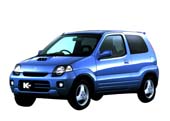|
Top Picks || Arts & Entertainment || Business & Economy || Education & Society ||
BACK IN THE FAST LANE: Redesigned Ultra-Compacts Boosting Car Sales January 6, 1999  Japan's automakers are doing big business in small vehicles like this. (Suzuki Motor Corp.) Japan's carmakers released their newest crop of sub-compact automobiles in October 1998. Redesigned to meet new safety standards, these cars are in hot demand right now. They are receiving critical acclaim for their enlarged bodies, which provide added safety, and for their prices, which remain on the low end. Given the world-wide trend toward smaller cars, Japan's carmakers are pinning their hopes on these new compacts to drag the auto industry out of its prolonged sales slump. Bigger Bodies, Added Safety at a Reasonable Cost Enlarging a car's body without altering displacement usually results in a decrease in engine efficiency. Moreover, the heavier the car, the poorer its fuel efficiency. The carmakers were confronted with the challenge of improving the cars' engine efficiency and reducing their body weight. Thanks to extensive research efforts, one maker put out four new ultra-compact models whose increased size led to an average weight only 10 kilograms (22 pounds) heavier than older versions, just one-fourth the weight increase that previous designs and materials would have led to. Moreover, the cars boast a 3.8% improvement in fuel efficiency. The other makers soon followed suit. Standardizing many of the cars' parts also led to reduced manufacturing costs, reflected in lower sticker prices. Sales have taken off. During a one-week span in the beginning of October 1998, 16 new models were released by six makers; 136,000 units sold in that month, 12% more than the previous year. November sales followed suit with 169,000 vehicles sold, a 30% year-on-year increase. With sales dropping over the 12-month period leading up to September, car companies have been taking a cautious, wait-and-see attitude toward the current boom. But these recent numbers are inspiring optimism in even the most skeptical of the makers. Will Ultra-Compacts Drive the Market? The mid-sized passenger car market is also undergoing a downsizing trend, with greater emphasis being placed on the cars' economy, fuel-efficiency, and environmental compatibility. Daimler-Benz (renamed DaimlerChrysler after a merger), more known for its high-powered luxury cars, has put out a scaled-down 1600cc mid-size auto that has garnered world-wide attention. This class of car is also gaining popularity in Japan. Ultra-compacts represent the final frontier in downsizing. But Japan's carmakers have built their presence up to now on smaller-sized standard autos, and rather than eat away at their bread-and-butter market, the makers have opted to continue to push the limits of technology and economy with the new ultra-compacts while leaving ample room for the promotion of the mid-sized cars upon which they have founded their reputation.
 Edited by Japan Echo Inc. based on domestic Japanese news sources. Articles presented here are offered for reference purposes and do not necessarily represent the policy or views of the Japanese Government. Edited by Japan Echo Inc. based on domestic Japanese news sources. Articles presented here are offered for reference purposes and do not necessarily represent the policy or views of the Japanese Government.
|
